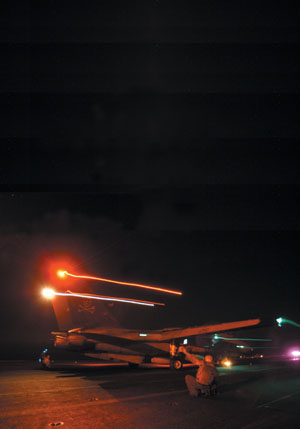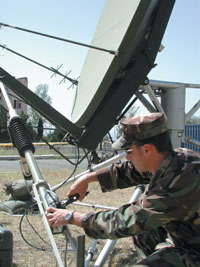FORCEnet Demands Drive Navy Command
 |
| A U.S. Navy F-14B Tomcat launches off the deck of the USS John F. Kennedy in support of operation Iraqi Freedom. Navy personnel in theater are requesting more elements of FORCEnet as they learn to exploit some of its capabilities. |
The U.S. Navy’s Space and Naval Warfare Systems Command may be taking on its greatest challenge to date with the implementation of the service’s FORCEnet effort. The complex endeavor, which is designed to be the linchpin of the Navy’s network-centric warfare thrust, will transform information into decisive effect.
Experts at the San Diego-based command, which is known as SPAWAR, are working on the road map for FORCEnet, which will require the establishment of standards that will be as important as building codes are to a neighborhood development. Yet, the command must concurrently implement FORCEnet capabilities urgently requested by forces in Southwest Asia as well as support those forces employing their new capabilities.
SPAWAR’s organization is positioned to sustain this type of effort. Separate program executive officers, or PEOs, focus on products. This permits headquarters to concentrate on engineering and overall integration. The PEOs are Space Systems, C4I (command, control, communications, computers and intelligence) and Space, and Information Technology (IT). They report directly to the Office of the Assistant Secretary of the Navy for Research, Development and Acquisition, which in turn pulls all of the programs together. Organizationally, they fall under SPAWAR for acquisition. The Navy/Marine Corps Intranet (NMCI) office, which resides under PEO IT, is treated as if it were a PEO.
Rear Adm. Kenneth D. Slaght, USN, SPAWAR commander, declares that FORCEnet is SPAWAR’s key program. “Simply stated, our most important tasking is to deliver FORCEnet—every aspect of FORCEnet from a technical and an acquisition point of view,” he emphasizes. “It’s simple to state, but I don’t think that everybody understands the full scope of FORCEnet, or at least what I think is the CNO’s [chief naval officer’s] vision of FORCEnet—that it truly is from the sensor through the network to the weapon.
“That is the [main] challenge. We need to tie all of that together,” he asserts.
The next challenges will involve integration into the joint world. The CNO’s direction is for FORCEnet to be “born joint,” and this effort is well underway. SPAWAR is working with the other services to ensure that becomes a reality, the admiral notes. This work includes leveraging off of U.S. Army and U.S. Air Force efforts to build common architectures. The Navy has invested in Army and Air Force contracts to build joint architectures, Adm. Slaght relates. The Navy also is engaged with the U.S. Joint Forces Command and the U.S. Strategic Command to map the alignment of FORCEnet programs to the joint level.
“The past two years have been a couple of the most dynamic years I have observed in my time here at SPAWAR,” Adm. Slaght says. “This truly is a new way of thinking.”
One reason that FORCEnet is challenging is because standard industrial-age approaches cannot work in the information technology arena, the admiral offers. The traditional blueprint of a single group owning and engineering a system is not viable with this type of technology. The admiral observes that no one ever owned the Internet, and that type of organizational construct is what must be brought to bear for FORCEnet-type capabilities.
“We have been pushing the envelope on the construct of network-centric warfare, and now we are starting to evolve to a network-centric organization,” he continues. This network-centric organization consists of SPAWAR, the Navy’s other acquisition organizations, the Naval Network Warfare Command (NETWARCOM) and the Office of the Chief of Naval Operations.
Further development of FORCEnet will require the establishment of “building codes,” Adm. Slaght offers. However, these codes will not necessarily be created or identified by just the Navy. The service is working closely with the Office of the Secretary of Defense, the Joint Staff, Joint Forces Command and Strategic Command to develop these architectures. SPAWAR has begun using these architectures to measure the programs’ technical compliance and their alignment for building FORCEnet.
An associated challenge is to support the true missions of FORCEnet. NETWARCOM has developed the first detailed concept of operations for FORCEnet, the admiral says. SPAWAR is using that document to align and link the technical compliance of programs with their ability to actually perform the mission. “That is where the rubber really meets the road,” Adm. Slaght emphasizes. “We will be able to take missions such as time-critical strike and be able to start to measure how all of the programs are able to support that, identify where the gaps are, determine where we need to accelerate a certain capability and ensure that we are able to fill that gap as quickly as possible.”
Ultimately, that will lead to an evolving definition of FORCEnet. Naval command and control (C2) may be one of the early recipients of a new definition. Adm. Slaght offers that the Navy needs to return to the fundamentals and basics of C2 to overcome the complexity that has permeated it with the addition of various new technologies and systems.
A more difficult task—but one that may be even more important—is to identify overlaps. The plethora of stovepipe programs developed in the past is straining resources as these legacy systems are connected to the network. Adm. Slaght questions whether this many systems are needed to perform a particular mission in the future.
For example, mission planning within time-critical strike efforts may involve as many as 80 systems—and that is within just the Navy. About 70 percent of those systems are or will be technically compliant with FORCEnet. The admiral offers that the next step will be to determine the best mix of those systems for the user. Not only is it probably not necessary to use all of those systems, but also this determination may help the CNO in his efforts to recapitalize the Navy, Adm. Slaght points out.
Foremost among the lessons learned in the two recent Southwest Asia wars is that network-centric capabilities must be deployed as rapidly as possible, the admiral says. Calling it “the number-one frustration that the CNO has faced throughout his career,” Adm. Slaght states that the acquisition world must respond better in a faster and more flexible manner. “Fighting the global war on terrorism has put the extraordinary exclamation point at the end of that,” he declares.
Several FORCEnet applications paid dividends during those operations. One example that Adm. Slaght cites is a maritime boarding operation undertaken by U.S. and Canadian ships against a Persian Gulf vessel suspected of harboring terrorists. Using the existing network, the Canadian destroyer linked back to the USS John Stennis to verify crew rosters via the wideband network in real time against Central Intelligence Agency and Federal Bureau of Investigation databases. A few years ago, examining this crew roster against terrorist files in the United States would have taken many hours over conventional radio circuits. The new capabilities allowed that search to be completed in a matter of minutes.
Adm. Slaght offers that this capability was taken from an idea “written on the back of an envelope” by acquisition and fleet officials. It took only six months to implement the actual linkage envisioned by these officials as a hypothetical situation that could—and did—come to pass.
However, the Navy is not meeting the challenge of rapidly implementing FORCEnet as well as it should, the admiral observes. While this effort has been improving, user demands amid ongoing operations are increasing the need for FORCEnet capabilities in the field.
The admiral emphasizes that one of the most important pieces of feedback that SPAWAR receives from battle group and strike group commanders is that they consider FORCEnet C4I capabilities to be combat systems. “They say, ‘I have to have it when I need it,’” Adm. Slaght relates. “It’s no longer something that they can afford to have go down and be down for extended periods of time, because they and the mission are at risk if that happens.” He adds that this mentality is very different from that of only about five years ago, when if a system went down, personnel would just pick up a radio and conduct operations. “We no longer can have the warfighters out there in the maritime environment at risk with that kind of scenario,” the admiral states.
Yet, the admiral warns against moving too fast. Falling into this pitfall could create more problems than are fixed, especially if a system addresses only a specific requirement but does not interoperate with the rest of the network. “We need to strike this balance better between taking the time to understand the impact of fielding a capability both from a technical and a mission support aspect, but also not engineering and studying this [issue] for years—which we also have been guilty of in the past.
 |
| A Navy electronics technician calibrates a super high frequency satellite dish that will provide Internet, telephone and videoconferencing capabilities. Available bandwidth remains a challenge as the Navy implements increasing degrees of FORCEnet. |
As with any information technology endeavor, industry will play a major role in SPAWAR’s efforts. Adm. Slaght cites the formation of the Network-Centric Operations Industry Consortium as an important step toward having industry operate like the services do. The consortium’s goal is to address network-centric capability and how industry will help the military solve common architectural issues, and this will help build the common infrastructure that the U.S. Defense Department will need for the Global Information Grid (GIG), the admiral observes. The Navy already has begun discussions with this group about its baselining process. “[The consortium] is a huge step forward,” he states. “It is a little early to tell how quickly it will gain traction, but we’re going to put it to the test as soon as we can.”
In terms of technology needs, Adm. Slaght says that two primary areas stand out. As always, bandwidth exploitation looms large. The constrained environment of ships at sea requires that the Navy take better advantage of bandwidth, he emphasizes.
The other is information assurance—specifically, the protection of the network. When experts model the network for both near-term and mid-term warfighting scenarios, information assurance looms as a big vulnerability, the admiral allows. He adds that this represents the first time that information assurance has knocked the need for bandwidth out of the top slot for network requirements, which is a development that industry should note.
The major FORCEnet Sea Trial is the annual TRIDENT WARRIOR exercise. Sponsored by NETWARCOM with SPAWAR serving as chief engineer, TRIDENT WARRIOR actually is a part of the Navy’s overall Sea Power 21 vision. FORCEnet pulls together all of those diverse elements in this event. In addition to exploring aspects of FORCEnet during sea trials, the process focuses on helping planners determine areas of emphasis. For example, if the top two FORCEnet requirements are to protect the network and expand bandwidth, then officials will look to industry through those lenses to ascertain what industry can contribute to solutions.
“We always will have a two-year gap between when we roll something out in trident warrior and when it actually can get into the POM [program objective memorandum] process, but we will be able to transition that gap much easier under the Sea Trial focus and, in our world, the trident warrior focus in the future,” the admiral offers.
FORCEnet is a significant part of the GIG, and SPAWAR is deep into several of its areas. The admiral notes that the command is working with the Defense Information Systems Agency (DISA) and the other services on the GIG Bandwidth–Expansion effort. Moving data down the last tactical mile is a major challenge with the GIG, and the Navy has some unique requirements with its shipboard environments. Activities with DISA, the Strategic Command and the Joint Forces Command are an important element that will continue to evolve, he states.
Above all, Adm. Slaght says, observers must not lose sight of the fact that FORCEnet is about business systems as much as it is about warfighting systems. The business systems will support the force’s ability to perform a warfighting mission through a number of areas such as logistics or even financial decisions. “I want to emphasize this because many people do not put this aspect into the FORCEnet bin,” he points out. “In the most powerful sense, FORCEnet has to transcend all of these issues, so our ability to deliver it is without a doubt the most important thing we do.”
Web Resources
SPAWAR: http://enterprise.spawar.navy.mil
FORCEnet: http://forcenet.navy.mil
AFCEA FORCEnet Evolution Presentation: www.afcea-sd.org/briefs/2002-10_afceasd_forcenet.ppt



Comments